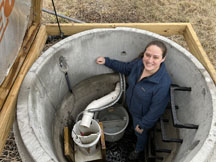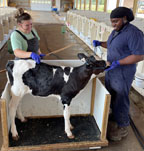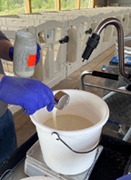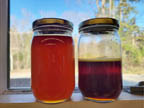
Chazy, New York. The farmer-driven Northern New York Agricultural Development Program (NNYADP) has announced that on April 18 Miner Institute Research Scientist Laura Klaiber will present the latest results-to-date of her agricultural tile drainage research as part of The Tile Drainage on Farms: Managing for Water Quality and Soil Health workshop. The workshop will be hosted virtually from 1:00 p.m. to 3:00 p.m. via Zoom and with additional limited in-person attendance available by reservation at the Cayuga County Soil and Water Conservation District building in Auburn, New York. For more information, visit cals.cornell.edu/tile-drainage-on-farms or contact PRO-DAIRY at 607-255-4478.
With grants from the NNYADP, Klaiber has been conducting research to build a foundational understanding of how agricultural tiling impacts the complex movement of water and nutrients into, across, and through soil.

Klaiber’s research began in the Lake Champlain watershed on land near Chazy provided by the New York State Department of Environmental Conservation in 2012; it is now conducted on a working dairy and crop farm in both tile-drained and non-tile drained fields equipped with edge-of-field monitoring technology.
“The farmers who guide the Northern New York Agricultural Development Program prioritized development of a real-world, data-based foundation for creating and refining best management conservation and agricultural guidelines that can work in tandem to protect both water quality and crop production success,” said NNYADP Co-Chair Jon Greenwood of Canton, New York.
Klaiber has presented her progressive project results and detailed data at conferences of farmers, soil and crop scientists, agronomists, soil health specialists, and natural resource conservation and management professionals. This will be her second presentation in New York’s Finger Lakes region. Her first was a virtual presentation for the 2021 Bob Brower Owasco Lake Scientific Symposium.
Reports of the year-to-year research quantifying the long-term agronomic and environmental aspects of tile drainage, including edge-of-field trial data on surface and subsurface water and nutrient movement, are posted on the NNYADP website at https://www.nnyagdev.org.
 Funding for the Northern New York Agricultural Development Program is supported by the New York State Legislature through the New York State Assembly and administered by the New York State Department of Agriculture and Markets.
Funding for the Northern New York Agricultural Development Program is supported by the New York State Legislature through the New York State Assembly and administered by the New York State Department of Agriculture and Markets.
Sponsors of the 2023 Tile Drainage on Farms: Managing for Water Quality and Soil Health Conference include Partners for Healthy Watersheds, American Dairy Association North East, Cayuga County Farm Bureau, Cayuga County Soil and Water Conservation District, Cornell Cooperative Extension of Cayuga County, North East Dairy Producers Association, New York Animal Agriculture Coalition, and Cornell CALS PRO-DAIRY.




